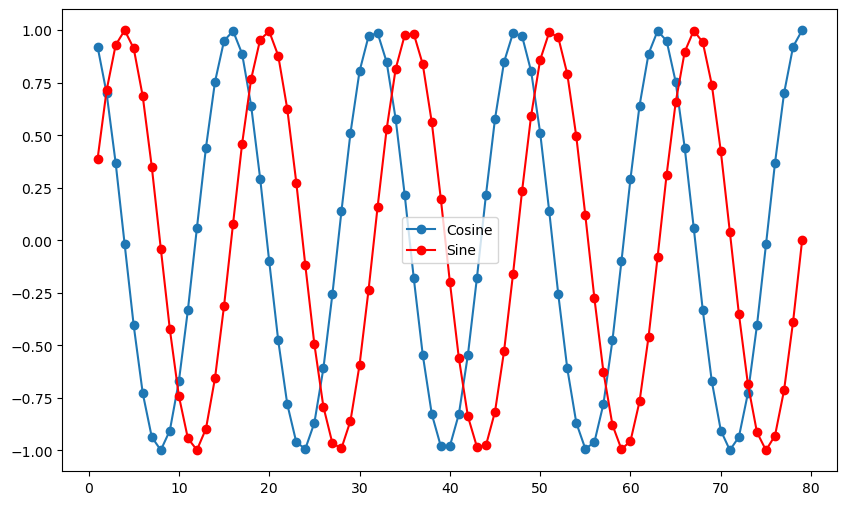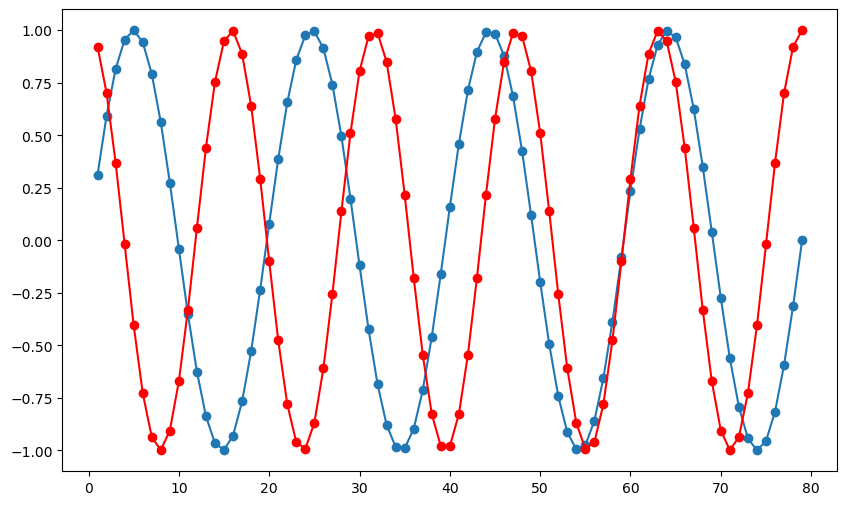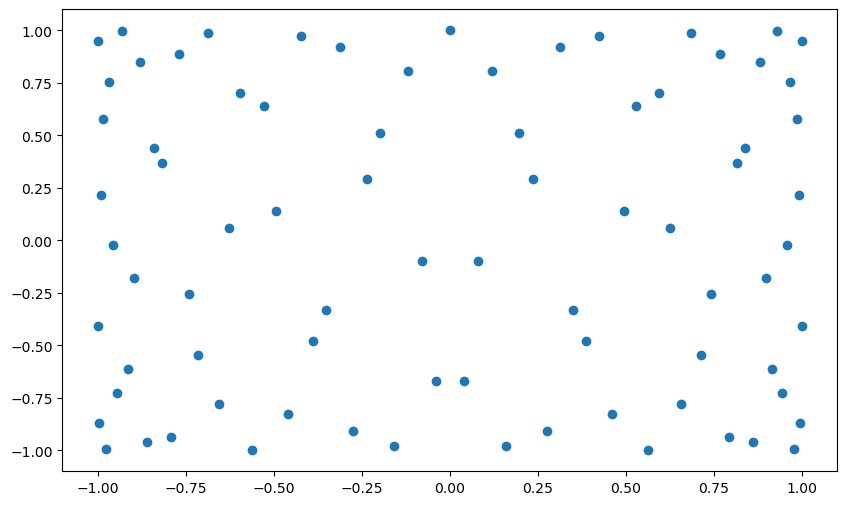Recall that a frequency is called Fourier Frequency (with respect to a sample size ) of is an integer.
Sinuosoids corresponding to Fourier frequencies will have an integer number of complete cycles within the observation interval.
import numpy as np
import matplotlib.pyplot as plt
import pandas as pd#Repeat the following plot when f is a Fourier frequency (e.g., f = 5/n) and when f is not a Fourier frequency (e.g., f = 5.5/n), and try to tell the difference from the plot
n = 79
f = 5.5/n #this is a Fourier frequency
t = np.arange(1, n+1)
y = 3 * np.cos(2 * np.pi * f * t) - 2 * np.sin(2 * np.pi * f * t)
plt.figure(figsize = (8, 4))
plt.plot(t, y, '-o')
plt.show()
Sinusoids at Fourier frequencies have the following remarkable orthogonality properties:
- Zero mean: .
- Constant energy: .
- Cos and Sin at same are orthogonal: .
- If are two distinct Fourier frequencies in , then , , , .
These properties can be easily verified in examples.
n = 79
f = 5/n
t = np.arange(1, n+1)
cos_t = np.cos(2 * np.pi * f * t)
sin_t = np.sin(2 * np.pi * f * t)
plt.figure(figsize = (10, 6))
plt.plot(t, cos_t, '-o', label = 'Cosine')
plt.plot(t, sin_t, '-o', color = 'red', label = 'Sine')
plt.legend()
plt.show()
print(np.sum(cos_t)) #should be zero if f is a Fourier frequency
print(np.sum(sin_t)) #should be zero if f is a Fourier frequency
print(np.sum(cos_t ** 2)) #should equal n/2 if f is a Fourier frequency
print(np.sum(sin_t ** 2)) #should equal n/2 if f is a Fourier frequency
8.881784197001252e-15
6.627323427154129e-16
39.49999999999999
39.5
f1 = 4/n
f2 = 5/n
cos_f1 = np.cos(2 * np.pi * f1 * t)
sin_f1 = np.sin(2 * np.pi * f1 * t)
cos_f2 = np.cos(2 * np.pi * f2 * t)
sin_f2 = np.sin(2 * np.pi * f2 * t)
plt.figure(figsize = (10, 6))
y1 = sin_f1
y2 = cos_f2
plt.plot(t, y1, '-o')
plt.plot(t, y2, '-o', color = 'red')
plt.show()
print(sum(y1 * y2)) #should equal zero if f1 and f2 are distinct Fourier frequencies

-1.3127843467054297e-15
plt.figure(figsize = (10, 6))
plt.scatter(y1, y2) #if f1 and f2 are distinct Fourier frequencies, there should be no linear trend in this scatter plot
Discrete Fourier Transform¶
For a dataset , its DFT is where
for . In other words, is a complex number with real part and imaginary part .
y = np.array([2, -5, 3, 0])
dft_y = np.fft.fft(y)
print(dft_y)
b0 = np.sum(y)
print(b0)
n = 4
#Here is the formula for calculating the real and imaginary parts of b2:
cos_4 = np.array([np.cos(2 * np.pi * 0 * (2/n)), np.cos(2 * np.pi * 1 * (2/n)), np.cos(2 * np.pi * 2 * (2/n)), np.cos(2 * np.pi * 3 * (2/n))])
b1_cos = np.sum(y * cos_4)
sin_4 = np.array([np.sin(2 * np.pi * 0 * (2/n)), np.sin(2 * np.pi * 1 * (2/n)), np.sin(2 * np.pi * 2 * (2/n)), np.sin(2 * np.pi * 3 * (2/n))])
b1_sin = np.sum(y * sin_4)
print(b1_cos, b1_sin)[ 0.+0.j -1.+5.j 10.+0.j -1.-5.j]
0
10.0 -1.3471114790620886e-15